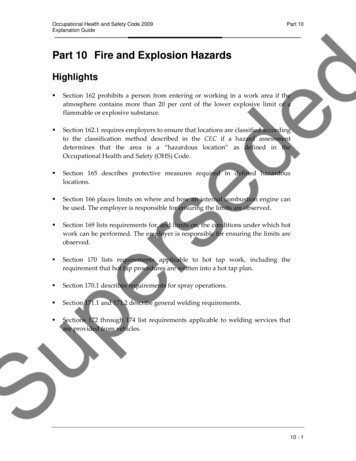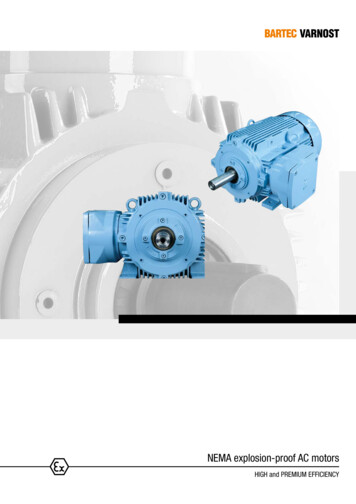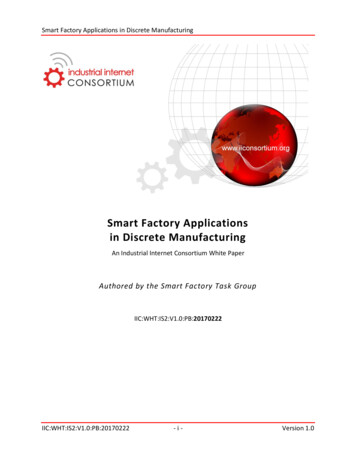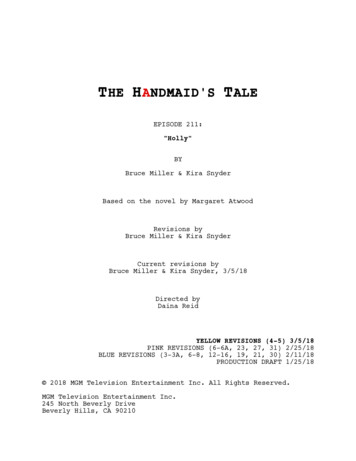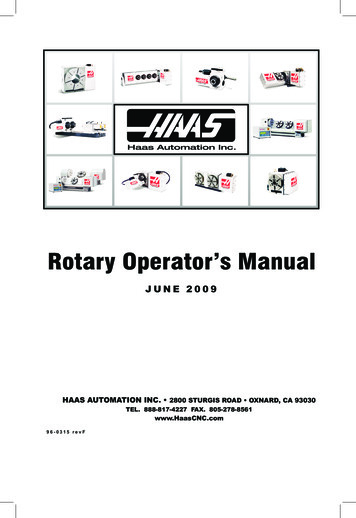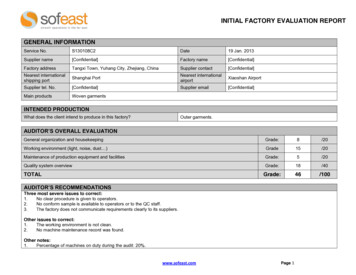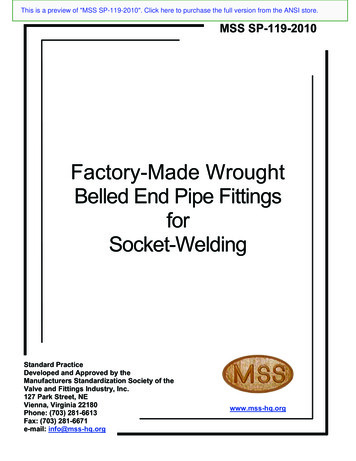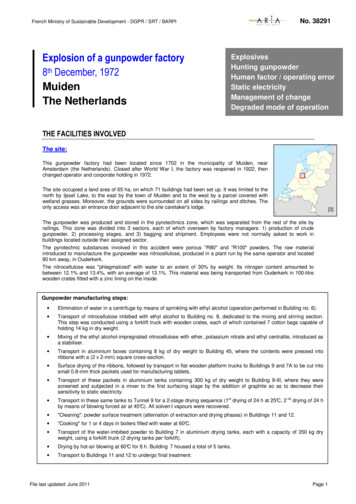
Transcription
No. 38291French Ministry of Sustainable Development - DGPR / SRT / BARPIExplosion of a gunpowder factory8th December, 1972MuidenThe NetherlandsExplosivesHunting gunpowderHuman factor / operating errorStatic electricityManagement of changeDegraded mode of operationTHE FACILITIES INVOLVEDThe site:This gunpowder factory had been located since 1702 in the municipality of Muiden, nearAmsterdam (the Netherlands). Closed after World War I, the factory was reopened in 1922, thenchanged operator and corporate holding in 1972.The site occupied a land area of 65 ha, on which 71 buildings had been set up. It was limited to thenorth by Ijssel Lake, to the east by the town of Muiden and to the west by a parcel covered withwetland grasses. Moreover, the grounds were surrounded on all sides by railings and ditches. Theonly access was an entrance door adjacent to the site caretaker's lodge.[3]The gunpowder was produced and stored in the pyrotechnics zone, which was separated from the rest of the site byrailings. This zone was divided into 3 sectors, each of which overseen by factory managers: 1) production of crudegunpowder, 2) processing stages, and 3) bagging and shipment. Employees were not normally asked to work inbuildings located outside their assigned sector.The pyrotechnic substances involved in this accident were porous "R80" and "R100" powders. The raw materialintroduced to manufacture the gunpowder was nitrocellulose, produced in a plant run by the same operator and located90 km away, in Ouderkerk.The nitrocellulose was "phlegmatized" with water to an extent of 30% by weight. Its nitrogen content amounted tobetween 12.1% and 13.4%, with an average of 13.1%. This material was being transported from Ouderkerk in 100-litrewooden crates fitted with a zinc lining on the inside.Gunpowder manufacturing steps: Elimination of water in a centrifuge by means of sprinkling with ethyl alcohol (operation performed in Building no. 6). Transport of nitrocellulose imbibed with ethyl alcohol to Building no. 8, dedicated to the mixing and stirring section.This step was conducted using a forklift truck with wooden crates, each of which contained 7 cotton bags capable ofholding 14 kg in dry weight. Mixing of the ethyl alcohol-impregnated nitrocellulose with ether, potassium nitrate and ethyl centralite, introduced asa stabiliser. Transport in aluminium boxes containing 8 kg of dry weight to Building 45, where the contents were pressed intoribbons with a (2 x 2-mm) square cross-section. Surface drying of the ribbons, followed by transport in flat wooden platform trucks to Buildings 9 and 7A to be cut intosmall 0.8-mm thick packets used for manufacturing tablets. Transport of these packets in aluminium tanks containing 300 kg of dry weight to Building 9-III, where they werescreened and subjected in a mixer to the first surfacing stage by the addition of graphite so as to decrease theirsensitivity to static electricity. Transport in these same tanks to Tunnel 9 for a 2-stage drying sequence (1st drying of 24 h at 25 C, 2 nd drying of 24 hby means of blowing forced air at 45 C). All solven t vapours were recovered. "Cleaning": powder surface treatment (alternation of extraction and drying phases) in Buildings 11 and 12. "Cooking" for 1 or 4 days in boilers filled with water at 60 C. Transport of the water-imbibed powder to Building 7 in aluminium drying tanks, each with a capacity of 350 kg dryweight, using a forklift truck (2 drying tanks per forklift). Drying by hot-air blowing at 60 C for 8 h. Building 7 housed a total of 5 tanks. Transport to Buildings 11 and 12 to undergo final treatment.File last updated: June 2011Page 1
French Ministry of Sustainable Development - DGPR / SRT / BARPINo. 38291The specific unit involved:Due to a partial reorganisation of factory operations, Building 7, located in the "crude gunpowder production" sector, wastemporarily housing a portion of the drying activities, which depended on output from the "treatment" sector.At the time of the accident, this building housed 5 tanks: 3 "dry" tanks containing hunting gunpowder of the "dirty" K 100type, and the other 2 "wet" tanks storing "cleaned" hunting gunpowder of the same type imbibed with water. Both wettanks had been placed online to replace 2 dry tanks, which remained nearby either on or adjacent to a forklift truckparked in front of the building entrance steps.Built in breezeblock with a corrugated iron roof, the building was divided into 4 compartments by means of 55-cm thickwalls:Eastern dryingchamber: 3 tanksWestern dryingchamber (2 tanks:one of the connectionpoints had beeninoperable due to thepoor state of repair ofthe correspondingsleeve)Machine room (containingelectrical machines andheating equipment for thedrying installation)"Antechamber"Building no. 7 entrance:60 cm high relative to theconcrete pavement, andramp leading to the path"Loading platform"Concrete pathAn "antechamber" occupied nearly the entire building length(15 m long by 2 m wide). Separated from the remainder of thebuilding by a 1-m thick wall, this antechamber had 2 points ofaccess: an interior wood door from the western dryingchamber, and an exterior door almost exactly opposite thefirst one, yet punctured into the building's southern facade.The building's northern facade was open, with the exceptionof the part at the level of the machine room. A set of entrancesteps circled both the western and northern sides of thebuilding, which had been equipped with a ramp leading to theconcrete path, providing access for a small transport vehicle.The building was also equipped with a 4.10-m loadingplatform on its southern side, from where the tanks wereloaded and unloaded using forklift trucks.[1]Another building (no. 7A) was close to Building 7, on the opposite side of the concrete path; built in breezeblock with acorrugated sheet metal roof, Building 7A comprised 2 workshops and 2 engine rooms. On the day of the accident, aworker was cutting 75 kg of gunpowder into ribbons inside one of the workshops.File last updated: June 2011Page 2
No. 38291French Ministry of Sustainable Development - DGPR / SRT / BARPIThe drying installation and safety features:The air in Building 7 was heated by a steam radiator, behind which a fan was blowing air at 60 C throu gh a 0.33-mdiameter duct. Between 1,700 and 2,000 m3 of air were thus being injected per hour per tank.A regulating thermostat stopped the supply of steam at temperatures exceeding 60 C; a second "high lev el" thermostatstopped the steam supply as well as the fan current.The tanks were connected from underneath; blown air was escaping through an aluminium lid fitted with a very fine (i.e.0.6-mm² mesh width) metal gauze. Drying time depended on the type of gunpowder being produced (8 h for "R100").The cylindrical drying tanks (diameter: 1.40 m, height: 1.71 m) were made of 4mm thick sheet aluminium. Their capacity was 1,500 litres for an unloadedweight of 150 kg, while a very fine metal gauze, cone-shaped screen with its topturned downward was placed in the lower part of each tank. The opening in thescreen bottom was closed by a dense detachable rubber ball. Two aluminiumrods were fastened onto the lower face of the drying tank so as to support thetank weight. These rods were designed so that the forks on the forklift could taketheir place exactly between two successive rods. During the drying process, thetanks were covered by a lid fitted with a very fine (0.6-mm² mesh width) metalcloth. During transport, the tanks were covered with a 20-mm thick plywood lid.The drying tanks filled with gunpowder were transportedbetween the various buildings by means of a platformtruck running on solid tyres and drawn by a small tractoron tyres activated by a four-stroke, 16-horsepower dieselengine with air cooling (see opposite). The engine exhaustpipe and muffler were both turned upward, and moreoverthe exhaust was fitted with a fireguard. The forklifts werespecially designed with features like: a smooth floor,shock-resistant edges, and dimensions for two tanks.Procedure used to exchange a "dry" tankfor a "wet" tankOnce the powder was dry (as validated byinspection), the technician was required tosweep the powder (dust) eventually found onthe floor and then wash the floor with largequantities of water using a pipe connected tothe water main. The air intake valve was thenclosed and the connecting sleeve as well asthe ground wire (for earthing) were removed.The lid fastening systems made of metalgauze were unscrewed, allowing to lift the lid5 cm with the help of a rope attached on theone side to the tank lid and on the other to alug on a grip fastened to the wall, while therope passed on a pulley above the tank. The"dried" tank could be slightly lifted by hand inintroducing a forklift, then moved and replacedby another tank filled with powder to be dried.[1]Reconstitution of a tank trans-shipment operation using a small forklift truck [1]File last updated: June 2011Page 3
French Ministry of Sustainable Development - DGPR / SRT / BARPINo. 38291THE ACCIDENT, ITS CHRONOLOGY, EFFECTS AND CONSEQUENCESThe accident:Around 8:35 am, two explosions a few tenths of a second apart occurred inside Building 7, generating a huge smokecolumn. Several witnesses confirmed seeing a lightning bolt before hearing the sound of the explosions.Fire-fighters, local gendarmes, elected officials, members of the military equipped to search through rubble, roademergency crews and local physicians all arrived on the scene to provide assistance to the victims.Consequences of this accident:Two factory employees aged 25 and 29 working inside Building 7 or standing at the building entrance were killed on thespot. Another employee was found seriously injured 90 min after the explosion in Building 7A rubble. Many of the site's140 workers were hurt to varying degrees by falling objects (ripped doors, tiles, etc.) or by broken window glass.Building 7 was completely destroyed; the only part left was a small section of the concrete entrance steps. The locationsof the 2 drying chambers were recognised by the presence of deep craters.Entrance to Building 7, viewed from the west (the damaged forest can be seen in the background) [1]View of the eastern crater (foreground) and western crater (background), as seen from the east.Between the two craters are the remains of the reinforced concrete floor from the machine room [1].File last updated: June 2011Page 4
No. 38291French Ministry of Sustainable Development - DGPR / SRT / BARPIBuilding 7A, located about ten metres away, was blasted apart, collapsed and then buried under considerable rubbleand debris from Building 7.Remnants of Building 7A (with debris and materials stemming from Building 7) [1]Many factory buildings were seriously damaged and all sustained broken windows. Several pipelines crossing thefactory were also destroyed.In the town of Muiden, 350 residences and buildings were slightly damaged with considerable broken glass (1,550shattered panes). Total property damage caused by this explosion was appraised at 1 million Dutch guilders.Damaged pipeline [1]Remains of the diesel tractor [1]The European scale of industrial accidentsBy applying the rating rules applicable to the 18 parameters of the scale officially adopted in February 1994 by theMember States' Competent Authority Committee for implementing the ‘SEVESO’ directive on handling hazardoussubstances, and in light of information available, this accident can be characterised by the four following indices:Hazardous materials releasedHuman and social consequencesEnvironmental consequencesEconomic consequencesThe parameters composing these indices and their corresponding rating protocol are available from the followingWebsite: http://www.aria.developpement-durable.gouv.fr.File last updated: June 2011Page 5
French Ministry of Sustainable Development - DGPR / SRT / BARPINo. 38291Nearly 2.45 tonnes (7 tanks of 350 kg) of gunpowder exploded; hence, the hazardous substances released index wasscored a level "3".Two employees died as a result of the accident, and at least one other was seriously hurt along with many more minorinjuries (estimated for parameter H5 at half the factory personnel, i.e. 70), resulting in a human and social consequencesindex rated at "4".Due to a lack of information on any environmental consequences, this parameter could not be rated.The amount of property damage caused by this explosion was valued at 1 million guilders, i.e. the equivalent of 1.5million in 2008. For this reason, the corresponding economic consequences index was assigned a "2".THE ORIGIN, CAUSES AND CIRCUMSTANCES SURROUNDING THIS ACCIDENTThe evaluation of craters, debris and projections from buildings and machines (including the tractor, platform truck,forklift, etc.) enabled investigators to conclude that all 7 tanks inside or adjacent to Building 7 detonated and moreoverthat the explosion source was located inside Building 7. This first blast then caused 2 dry gunpowder tanks to explodeon the platform truck parked outside the building.Several hypotheses (eventually combined) were envisaged in order to explain the phenomenon, yet a 25-year-oldtechnician considered relatively inexperienced and a sequence of incorrect manipulations (operating errors) werestrongly suggested as exacerbating factors: The drying tank lid fitted with metal gauze could have been opened in an untimely manner and hoisted prior toclosure of the air intake, thereby causing dispersion inside the room of a distinct amount of dry gunpowder. Ifthe floor had not been previously watered, then this gunpowder could have ignited subsequent to a blow orshock, which in turn would have spread fire to the tank. Since the lid had been hoisted and the cable fastened to the grip lug (after removal of the drying tank), thecable might have become detached or slid off the lug, causing the lid to drop a height of more than 1.75 m ontothe drying chamber floor. Combined with a floor that had not been swept and/or watered, traces of gunpowderon the floor could have ignited. The ignition of gunpowder on a floor that had not been swept and watered could also have arisen as a result offorklift wheel friction (less likely given the spot where the forklift was found after the accident). An electric motor on the drying installation's fan could have been heated, and in so doing generated sparks orflames that, when blasted through the pipelines, would have ignited gunpowder in the drying tank. Phenomenon of static electricity: the lid, which had not been grounded, could have become electrostaticallycharged, and an electrostatic discharge with sparking would then have triggered ignition.Lastly, the hypothesis of a negligent smoker cannot be entirely discarded, even if this cause of ignition seems highlyunlikely.ACTIONS TAKENSeveral investigations were conducted (gendarmerie, labour inspection office, TNO1 technical departments, etc.),complete with questioning of employees, testing on suspected pyrotechnic substances and reconstitutions.The rebuilt factory would experience two other fatal accidents, on 30th May 1983 (storage depot explosion: 3 deaths) and9th September 1983 (explosion: 1 death) [2, 3].On 25th November 1986, the site closed a portion of its operations; then, on 10th December 1990, the company wasdeclared bankrupt. It was purchased by a British company and activity resumed on 24th August 1991 [2].LESSONS LEARNTGiven the quantities of substances simultaneously present in and near Building 7, as well as the protection systems inplace in both this building and Building 7A, the accident highlights the importance of good installation design, including:location away from buildings, limitation of the rated values2 inside buildings, decoupling of loads capable of reactingsimultaneously, recognition of the relay effect (e.g. via internal transport) and domino effects.1TNO (Toegepast Natuurwetenschappelijk Onderzoek, Dutch organisation for applied research): A Dutch expert appraisalcommittee, along the lines of France's INERIS Institute.2Maximum authorised quantity.File last updated: June 2011Page 6
French Ministry of Sustainable Development - DGPR / SRT / BARPINo. 38291The sources consulted did not explicitly mention the extent to which the partial reorganisation of factory operations (seepage 2) might have affected circumstances surrounding this accident. Nonetheless, a study of the accident indicates theimportance to be ascribed to managing such organisational modifications from a safety standpoint, e.g. risk analysis orcloser executive oversight.Along the same lines as the Pont-de-Buis gunpowder factory accident in 1975 (ARIA 147453), the risks of gunpowderexplosion were poorly identified and moreover the resources allocated were insufficient to provide protection against theeffects or propagation of an explosion (safety distances, types of materials used, etc.). The quantities of materialspresent in the buildings were also much greater than those commonly used today; the risk at the source has since beenreduced.These two accidents helped give rise to noteworthy changes in French pyrotechnics regulations (Decree no. 79-846enacted 28th September 1979, and the 26th September 1980 administrative order), stipulating among other thingsworkplace safety reports for all pyrotechnic operations, along with a series of both technical and organisationalprevention / protection measures still in effect today.Rubble that was once Building 7A [1]SOURCES (INCLUDING PHOTO CREDITS) [1] Report issued by the Dutch Labour Inspection Office on the explosion of the Muiden gunpowder factory,A. Balemans, J. Bezemer and B. Van Elburg, 1973 [2] .html [3] http://en.wikipedia.org/wiki/Muiden3This accident was the subject of a detailed report, which can be consulted on the ARIA ile last updated: June 2011Page 7
The site occupied a land area of 65 ha, on which 71 buildings had been set up. It was limited to the . pot assium nitrate and ethyl centralite, introduced as . a second "high level" thermostat
